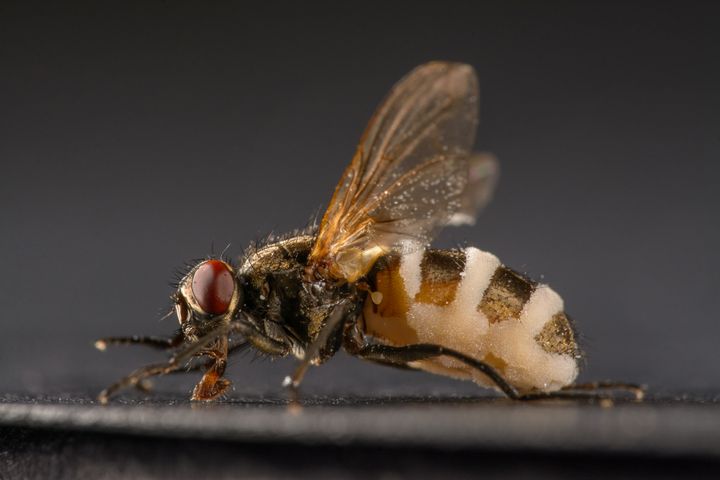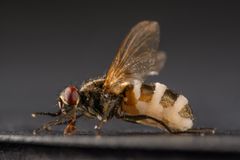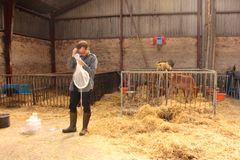New knowledge about a fungus that turns 60-80% of the flies in your home into zombies
How can a fungus take over a fly's behavior? An international group of researchers with participation from the University of Copenhagen hopes to find out with the help of a new genetic map of a unique fungus that transforms 60-80 percent of the flies in your home into zombies. In the future, the fungus could become both an effective insect repellent and basis for new psychotropic drugs.

What can we learn from a fungus that eats most of the flies in your home from the inside, turns them into zombies and then lures other flies to necrophilic intercourse? Possibly quite a lot, according to researchers at the University of Copenhagen.
Henrik De Fine Licht has been researching this very special fungus for years, a fly fungus – Entomophthora muscae – that takes over the behaviour of flies before killing them.
Most recently, he and a group of American research colleagues have succeeded in mapping the fungus’ genome, an achievement in itself because the massive genome is roughly 25 times larger than that of most other fungi. The goal is to find out how the fungus manipulates fly behavior.
"The genome is a catalogue of all the genes found in the fungus, which tells us something about the the organism’s capabilities. Such a catalogue can better equip us to look at which genes are active in a fly’s brain at the point when the fungus transforms it into this zombie-like state. And in this way, we hope to understand how it can do such a wild thing," says Associate Professor Henrik De Fine Licht of the University of Copenhagen’s Department of Plant and Environmental Sciences.
The new study has been published in the scientific journal eLife.
Makes fruit flies and houseflies necrophilic
Fly mold grows exclusively in flies. One subspecies of the fungus specializes in houseflies, while another uses fruit flies as hosts. The fruit fly-infecting subspecies was the one that the researchers sequenced the genome of in this study.
"Research has shown that up to 60-80 percent of the flies that fly around in a given room or cattle barn can be infected with this fungus. Zombie flies are typically found when one comes across a dead fly sitting on a window surrounded by a white ring of spores," says Henrik De Fine Licht.
Once the fungus has infected a fly, it eats the fly from the inside over the course of a week or so while the fly is alive. When nearly all of the fly’s nutrients have been consumed, the fungus starts to manipulate the brain and begins to take over the fly's behavior. It causes the fly to stick to a plant or window, as high up as possible.
"At this point, almost the entire body consists of fungal mass, and eventually all of the fly’s normal processes stop. Over the course of a few hours, the fungus begins to shoot fungal spores out of the hind of the fly's body. In the process, it also secretes chemical fragrances that attract healthy flies. Once close, they try to mate with the dead flies, which allows the spores to grow into the healthy fly and repeat the process," explains the researcher.
The genes provide new knowledge about the fungus' unique properties
While the fungal life cycle is well described, very little is known about how it all works. The new map of the fungus’ genome will probably be able to shed light on this.
In the new study, the group of researchers – which includes biologists from Harvard University – have discovered, among other things, that the fungus has a few unique genes which add perfect timing to the zombification equation:
"The behavioural manipulation always begins at dusk. We think this is adaptive for the fungus because humidity is higher at night, so it’s a better time to release infectious spores that are prone to drying out We now know that the fungus has genes that code for light-sensitive proteins. We suspect that, just like in other organisms, the fungus could be using light cues to tell the time. Thus, we believe that this is important clue in the mechanism underlying the timing of behavior manipulation," says last author Carolyn Elya of Harvard University.
Furthermore, the genome shows that the fungus has many copies of enzymes that are good at breaking down the hard chitin shells of insects.
"This reflects that the fungus has a unique evolutionary adaptation to grow and live in insects. While unsurprising, it has now been verified for the first time," says Elya.
Could be used for psychotropic drugs in the future
Even though this is fundamental research, Henrik De Fine Licht believes that there are several ways that humans could put the lessons of this fungus to good use in the future, should researchers be successful in revealing even more about its secrets:
"Understanding how the human brain works in relation to behaviour is often a challenge because it is difficult to measure precisely. But here, we have a system with a very defined behavior that we know is controlled by a fungus in the brain of an insect. If we understand how the fungus operates, we can begin to map the entire sequence from genes and molecules to behavior," says the researcher, continuing:
"And then, one may be inspired by the chemical substances and certain mechanisms that the fungus deploys to manipulate the fly's behaviour when, for example, designing new drugs for mental illnesses in humans."
In another sphere, there is the possibility of using the fly fungus for biological pest control. Because one of the disadvantages of both chemical pesticides and fungicides on the market today is that they attack many types of insects. Here, the fungus' specialized behavior can make a difference.
"Typically, you only want to target pests, while steering clear of honey bees and other beneficial insects. So, if further research leads to the development of an insecticide based on this fungus, which has the great advantage of only attacking one species of fly, it would be very, very attractive," concludes Henrik de Fine Licht.
ABOUT THE STUDY
- In addition to Henrik De Fine Licht and Carolyn Elya, the researchers behind the study are: Jason E. Stajich of the University of California-Riverside, United States; Brian Lovett of USDA-ARS, United States; Emily Lee and Benjamin L. de Bivort from Harvard University, United States, Ann E. Hajek from Cornell University, United States, and Angie M. Macias and Matt T. Kasson from West Virginia University, United States.
- The research article about the study has been published in the journal eLife.
Keywords
Contacts
Henrik De Fine Licht
Associate Professor
Department of Plant and Environmental Sciences
University of Copenhagen
hhdefinelicht@plen.ku.dk
+45 35 32 00 97 / +45 61 68 57 69
Maria Hornbek
Journalist
Faculty of Science
University of Copenhagen
maho@science.ku.dk
+45 22 95 42 83
Images
Links
ABOUT THE FACULTY OF SCIENCE
The Faculty of Science at the University of Copenhagen – or SCIENCE – is Denmark's largest science research and education institution.
The Faculty's most important task is to contribute to solving the major challenges facing the rapidly changing world with increased pressure on, among other things, natural resources and significant climate change, both nationally and globally.
Subscribe to releases from Københavns Universitet
Subscribe to all the latest releases from Københavns Universitet by registering your e-mail address below. You can unsubscribe at any time.
Latest releases from Københavns Universitet
Fermentering gør havets grøntsager mere spiselige5.12.2025 06:18:59 CET | Pressemeddelelse
Tang har længe været hyldet som en bæredygtig superingrediens – men dens “fiskede” smag er en barriere for mange vestlige forbrugere. Nu viser et nyt studie fra Københavns Universitet, at fermentering med mælkesyrebakterier kan være nøglen til at få tangen til at glide ned.
P-piller kan forringe kvinders mentale trivsel2.12.2025 06:05:00 CET | Pressemeddelelse
Adgang til p-piller i ungdomsårene er forbundet med øget risiko for depression senere i livet. Især kan kvinder, der er genetisk disponeret for psykisk sygdom, risikere at blive ramt af bivirkningen. Det viser et nyt studie fra Københavns Universitet.
Psykologer: Derfor kan protester samle folk på tværs af politiske skel27.11.2025 09:18:05 CET | Pressemeddelelse
Hvordan kan mennesker med diametralt modsatte holdninger pludselig stå skulder ved skulder i protest? Det spørgsmål har et internationalt forskerhold undersøgt. Udgangspunktet er COVID-protesterne, som blev båret af tre samlende strategier.
Sådan bruger planter ingeniørprincipper til at trænge gennem hård jord27.11.2025 07:16:00 CET | Pressemeddelelse
Et internationalt forskerhold med Københavns Universitet, Shanghai Jiao Tong University og University of Nottingham i spidsen har opdaget, hvordan planterødder er i stand til at trænge igennem hård og tæt jord ved hjælp af et velkendt ingeniørprincip. Opdagelsen kan få stor betydning for fremtidens afgrøder i en tid, hvor presset på landbrugsjorden stiger.
Forskere advarer: Klimaforandringer kan udvide levesteder for malariamyg27.11.2025 06:00:00 CET | Pressemeddelelse
Hvis vi ikke begrænser klimaforandringerne, så risikerer vi, at malariamyg udbreder deres levesteder i Afrika betydeligt. Det vil udsætte mange hundrede millioner mennesker for en højere smitterisiko.
In our pressroom you can read all our latest releases, find our press contacts, images, documents and other relevant information about us.
Visit our pressroom

